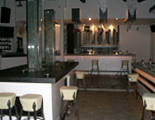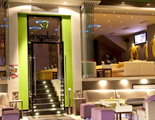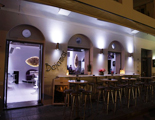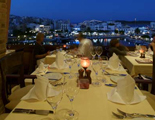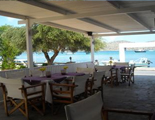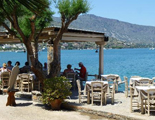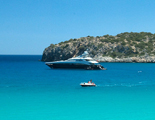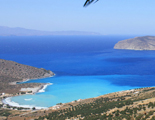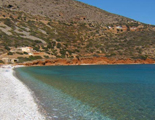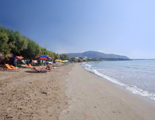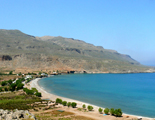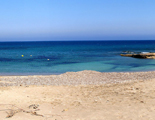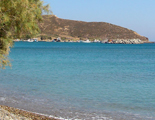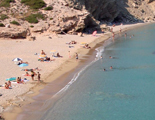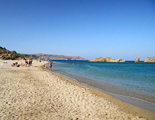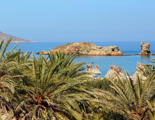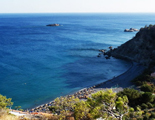 Lasithi Travel Guide
Lasithi Travel Guide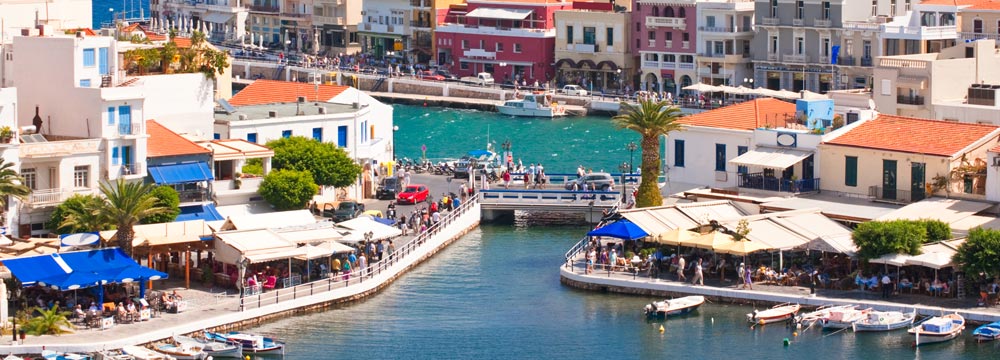
There are two possible scenarios concerning the origin of Lasithi name. The first one supports that it derives from the name of Sitia town, which the Venetians used to scribe it as “La Sitti”. According to the second one, Lasithi comes from the ancient Greek word “Lasios” meaning lush, which is hardly the case of Lasithi’s morphology nowadays!
In antiquity, in the place where nowadays stands Agios Nikolaos, the town Lato pros Camaran was situated, serving as a seaport of Lato pros Eteran, a prosperous city-state during the archaic and the classical period. The area’s inhabitance history starts from the Neolithic period (5700-2800 BC) and, just like it happened with the rest of Crete, the Minoan civilization followed until its collapse in 1100 B.C. After the Minoans came the Dorians, when the ancient cities of Lasithi flourished, to pass in turn under the Roman rule. Crete and its four prefectures were finally integrated in the Byzantine Empire until 1204, with a small interruption by the invasion of Arabs in 824 that lasted about a century.
After the fall of the Byzantine Empire the Genovese became the rulers of Crete. In 1206 Genovese pirates built the castle of Mirabello (meaning beautiful view in latin) which later came to the hands of the Venetians. Mirabello was finally destructed by the Turks in 1647.During the Venetian period the Cretans managed to develop their culture and commercial activities although rebellions against the Venetians were not scarce.
The entire island of Crete was dominated by the Turks in 1645 despite and hard resistance from both Venetians and Cretans. Crete was recognized as an autonomous state after 1867, under the sovereignty of the Sultan. It finally became a part of Greece in 1912.
According to Greek mythology, the Titan Rhea, wife of the Titan Cronus, gave birth to Zeus in Dikteon Cave in Lasithi, to protect him from his father. Cronus used to eat his children to preserve his authority, believing in a legend that said one of them would dethrone him. Rhea tricked Cronus by delivering a rock wrapped in swaddling clothes, which he swallowed.
After Zeus was born, Rhea took him to Ideon Andron, where he was raised with the care of nymph Melissa and the mythical goat Amalthea. Seven giants, called Kourites, were guarding the Cave and every time that little Zeus was crying, they were clanging their swords on their shields producing a great noise so that Cronus would not hear the child’s cry.
When Zeus became strong enough, he released his brothers and sisters from his father’s stomach and eventually claimed the throne.
Lasithi prefecture, just like Chania, Rethymno and Heraklion, is full of traditional villages and historical settlements scattered throughout its extend.
Cycladia offers you a tour of the main spots you should definitely visit in order to feel the unique aroma and ambience of this majestic place!
KATO ZAKROS
Kato Zakros is one of the principal settlements of the eastern coast. The landscape here is particularly wild and imposing as it is composed by giant, bare mountains and steep slopes on one side and the endless Libyan Sea on the other. The place is full of archeological findings, such as the ancient Minoan palace of Zakros, so it has remained mostly pure and untouched for the antiquities’ sake. However, you will find some basic accommodation units and traditional taverns with authentic Cretan specialties. You can access Kato Zakros by car or bus, or even on foot through the famous Gorge of the Dead (almost 2 hours walking).
PALEKASTRO - ANGATHIAS
The wider area of Palekastro is a place of genuine Cretan tradition, untouched by modern development. Palekastro is one of the main villages of the prefecture offering accommodation, traditional taverns and a few cafes. Angathias is a very small village right next to Palekastro with small stone paved alleys and very old, mostly abandoned buildings. Both settlements offer easy access to nearby beaches like Chiona and Kouremenos.
The archeological site of Pressos in located northeast of Agios Nikolaos. This was the town of the Eteocretans, the descendants of Minoans. The Eteocretans together with the Dorians built the new town in the 12th century, from which only remains survive today.
The town had two ports, one in the north (Itia or Sitia) with access to the Cretan Sea and one in the south (Stiles) with access to the Libyan Sea. The town was destroyed by Ierapytna in 146 B.C.
The excavations on the site brought to light a Hellenistic palace and objects made of copper and clay, helmets, shields and three plates with Eteocretan writings.
The archeological site of Gournias is located 18 km northeast of Agios Nikolaos. A Minoan settlement was found here with houses, roads and a big building on the hill top, considered to be the house of the town lord. The town was built in 1600 B.C. and was destroyed around 1450 B.C. like the rest of the Minoan Palaces. The name Gournias comes from the small ponds (gournes in Greek) found in the site.
Almost 10 km southwest of Agios Nikolaos, in Kondaratos, lay the ruins of the ancient Dorian town Lato pros Etera. The mother of the ancient Gods Apollo and Artemis, Lito gave its name to the town. The name Etera (meaning “different” in Greek) was given to distinguish it from its seaport Lato pros Camara (Agios Nikolaos). Lato was one of the most powerful towns of Crete and the archeological site includes public buildings, the agora, forming a pentagon, and lots of houses.
The archeological site of Ancient Zakros is located about 8 km northeast from Zakros village and 39 km from Sitia were today lies the small settlement of Kato Zakros in the easternmost spot of Crete. It was the 4th and smallest Minoan Palace of Crete and the only one that has not been plundered. Built around 1600 B.C. in a similar pattern with the Palaces of Knossos and Festos, it covers 8000m2 and consists of 180 departments.
The excavations brought to light important findings such as vessels, swords with golden foils, ivory objects, ornaments made of copper from Cyprus, all exposed in the Archeological Museum of Heraklion.
Named after its Phoenician founder Itanos, this town flourished from the trade of glass and porphyra (a natural dye coming from sea shells). Another important factor for Itanos’ prosperity was the temple of Dikteon Zeus, located in Palekastro, which, apart from great profit, it also brought about a lot of conflicts over its control with Ierapytna and Pressos. Itanos was destroyed by an earthquake in 795 B.C. and then by the Arabs in the 9th century. Today the place is full of scattered ruins such as the outpost in the west citadel and the Early Christian church in the east citadel, the Early Christian temples on the foot of the hill leading to Vai area and the cemetery outside the town.
The fortress of Spinalonga was built in 1579 on a small island named Kalydon protecting the gulf of Mirambello. Its solid structure and big canons kept it impregnable during the war between the Venetians and the Turks. In the first half of the 20th century (1903-1957) the island operated as a hospital for the lepers by the Cretan State. The name Spinalonga comes from an expression “Stin elounda”, “Stinelonda”, which the Venetians changed it to spina, which means thorn, and longa, meaning long. Therefore Spinalonga means long-thorn. Visitors can access the island by boat from Elounda and Plaka.
One of the richest and most prosperous monasteries in Crete is the Monastery of Toplou. It is located 6 km north of Palekastro and was constructed in the 15th century in a rectangular shape, surrounded by a thick wall 10m tall. Its principal characteristic is its 33m high bell tower. During the Turkish occupation it served as a refuge for the rebels and during the German occupation it was the basis of a secret radio station by the resistance.
Very well preserved murals of the 14th century decorate its walls and plenty of distinct paintings such as "Axion Esti" by I. Kornaros in 1770.
Toplou is also a producer of fine olive oil and biological wine.
Gorge of Ha
Gorge of Ha is located near the village Kato Horio in the mountain of Thrypti, north of Ierapetra, and is about 1km long. The entrance of the gorge is only about 3m wide and its narrowest pint is 30cm. Towards its end the highest waterfall in Crete is found (215m height). The gorge is rich in flora and fauna, despite the fact that its largest part was burnt in 1984 and in 1987. It is considered to be the wildest and most dangerous gorge of Crete and it is not recommended for amateurs, without proper equipment and a guide.
Gorge of the Dead/Zakros
In the Municipality of Itanos, 39 km east of Sitia, the Gorge of the Dead or Zakros Gorge is found. Its entrance is near the village of Ano Zakros and it ends at Kato Zakros. The scenery is fascinating but wild and bare, so make sure you are supplied with water and a hat. You will encounter plenty of small caves which served as tombs during the Minoan era, hence the name Gorge of the Dead.
Pervolakion Gorge/Kapsa
This beautiful gorge is in the south east part of the prefecture, almost 9km away from Makrigialos to the east. Near its mouth to the seashore is the Kapsa Monastery. The Gorge is about 4 km long, leading to the village Pervolakia and crossing it takes about 2hrs. It is easily accessible with only a few steep spots and the scenery is arid but very imposing.
Oreino Gorge/ Red Butterflies’ Gorge
Oreino Gorge starts from the village Oreino, leading after a 4 hour hiking to the seaside Koutsouras village, in the south. It is named after the red butterflies that lived in it but while a big fire in 1993 burnt a part of it reducing the red butterflies’ population, the flora is still lush.
Selinari Gorge
Selinari Gorge is located between Heraklion and Agios Nikolaos in the eastern part of Selena Mountain. It is a natural passage from Lasithi to Heraklion north coasts. Selinari has lush vegetation and you can cross it on foot or by car following the old National Road. The gorge and the surrounding mountains shelter many birds and, once, the rare wild goat of Crete (kri kri).
Richtis Gorge
The gorge of Richtis is located between Agios Nikolaos and Sitia. Its entrance is just outside the village Exo Mouliana and exits at the pebbly beach of Richtis. Its length is about 3 km and the hiking takes approximately 4 hours. The gorge has plenty of water, even in summertime, and a waterfall of 15m height. You will also meet some old water mills.
Archeological Museums
The Archeological Museum of Ierapetra was founded in the end of the 19th century and today is housed in the building of the Ottoman Commercial School.
The exhibits include objects of Minoic to Hellenic-Roman art such as sculptures, statues and tomb writings.
The Archeological Museum of Sitia was founded in 1984 and its collection includes findings from the later Neolithic until the later Roman period, along with the marvelous figure made of gold and ivory, which was found in the Minoic town of Palekastro, findings from the Minoic Palace of Zakros and from Sitia area.
Agios Nikolaos’ Museum hosts the most recently excavated objects from eastern Crete, such as early Minoic findings from Myrtos, figurines and pottery items from the region of Mohlos, vessels from the archeological site of Zakros, and various other objects from Sitia and Elounda.
The Folk Museum of Sitia is housed in a traditional building owned by the Municipality and its collection is constantly enriched. The exhibits include all kinds of traditional Cretan house objects, traditional furniture, clothes and costumes and old embroideries which are a real work of art. There is a traditional kitchen, with furniture and all necessary cooking utensils and tools for the preparation of dishes and sweets, and an old loom with all its accessories.
Location: Ierapetra
CLIMATE
Lasithi is located in the easternmost part of Crete. Its climate is a typical Mediterranean climate with hot and sunny summers and mild winters with moderate rainfalls and cold. Especially in August, strong southern winds, called Meltemia, that make it difficult to access by boat the islets at the north, such as Chrisi Islet.
TELEPHONE
The national prefix for Greece is +30 if you are calling from abroad. All numbers in the capital Athens start with the prefix 210 and are followed by 7 digits (e.g. 210-3227400).
The Area Code for Agios Nikolaos is +30 28410, for Ierapetra +30 28420 and for Sitia +30 28430.
If you wish to call abroad, you have to start by dialing the other country’s national prefix (i.e. 0049 for Germany, 0044 for England etc.) and continue with the area code and the number where you wish to call.
CURRENCY
Euro €
Euro Coins: 1 and 2 euro coins (gold and silver color), 10, 20 and 50 cents (gold color) 1, 2 and 5 cents (copper color)
1 euro = 100 cents / centimes.
Euro Bank Notes: Are available in 5, 10, 20, 50, 100, 200 and 500. It is not always easy to receive change for 200 and 500 Euro Notes.
BY AIR
The airport of Sitia is connected with Athens airport and also with Rhodes, Karpathos and Kasos islands. You can also catch a flight to Heraklion and then take the long distance bus (KTEL) to Lasithi (about 65km).
Athens International Airport Eleftherios Venizelos: www.aia.gr
Sitia Airport: +30 28430 24424
Olympic Airways: For accurate timetable and ticket costs visit Olympic Air website www.olympicair.com
Athens Office: +30 210 355 0500, 8018010101
Aegean Air: For accurate timetable and ticket costs visit Aegean Air website www.aegeanair.com
Tel.: 801 112 0000/+30 210 6261000
BY BOAT
The port of Piraeus is connected with the port of Agios Nikolaos and the port of Sitia via Milos and Santorini in Cyclades. The trip lasts about 12-18 hours but the itineraries are subject to changes each year.
There is also the option to travel from Piraeus to the port of Heraklion, since there are frequent routes and the trip is much shorter (about 6.5 hours). From there you can travel to Agios Nikolaos by a long distance bus or private vehicle.
Aegeonpelagos: For accurate timetables and ticket costs visit Aegeon Pelagos Lines online booking engine: booking.aegeonpelagos.gr
Anek Lines: For accurate timetables and ticket costs visit Anek Lines website www.anek.gr
Tel.: +30 210 4197470
E-mail: [email protected]
Minoan Lines: For accurate timetables and ticket costs visit Minoan Lines website: www.minoan.gr
Tel.: +30 210 3376910
E-mail: [email protected]
Piraeus Port Authority: +30 210 42 26000
Agios Nikolaos Port Authority: +30 28410 90108
Ierapetra Port Authority: +30 28420 22294
Sitia Port Authority: +30 28430 22310
LOCAL BUSES
The long distance bus service (KTEL) is connecting the three major towns of Lasithi between them and with the city of Heraklion. From the central stations, KTEL busses reach various villages and settlements too.
KTEL Agios Nikolaos Tel: +30 28410 22234
KTEL Ierapetra Tel: +30 28420 28237
KTEL Sitia Tel: +30 28430 22272
TAXI SERVICE:
Agios Nikolaos: +30 28410 24000
Ierapetra: +30 28420 26600
Sitia: +30 28430 22700
RENT A CAR/MOTORBIKE
Crete is ideal for renting a car or a motorbike. The routes are unique and the landscape can change quickly from seascape to mountainous sceneries and from landscapes with lush vegetation to bare, lunar landscapes. However you must pay attention because, except for the National highway, the roads are usually narrow, winding and not well maintained.
BANKS & ATMS
In the three major towns of Lasithi you will find branches of almost all Greek banks. ATMs are more usual in smaller settlements too.
MONEY EXCHANGE
Banks exchange all major currencies, traveler’s cheques or Eurocheques. Post offices exchange cash, but not traveler’s cheques, and usually charge lower commissions than banks. Travel agencies and larger hotels exchange cash and traveler’s cheques but usually charge a higher commission. Credit cards are widely accepted in shops and restaurants, however, in local cafes, especially in villages you will most probably have to pay only in cash.
POST OFFICE
The Greek post office is called ELTA. Post Boxes in Greece are YELLOW for normal post, usually with 2 slots for INTERNAL POST (meaning inside Greece) and post for ABROAD. RED Post Boxes are rarer and they are used for URGENT mail. REGISTERED mail is always handled and given a receipt for at the POST OFFICE.
Post Office in Agios Nikolaos Tel. no: +30 28410 3744
Post Office in Elounda Tel. no: +30 28410 41312
Post Office in Ierapetra Tel. no: +30 28420 22271
Post Office in Sitia Tel. no: +30 28430 22283
POLICE STATION
Agios Nokolaos Police Station. Tel.: +30 28410 91406
Ierapetra Police Station. Tel.: +30 28420 90160
Sitia Police Station. Tel.: +30 28430 22259.
Municipality of Agios Nikolaos
Municipal Tourist Information Office of Agios Nikolaos
Tel.: +30 28410 22357
E-mail: [email protected]
Municipality of Ierapetra
Tel.: +30 28423 40300
Website: www.ierapetra.gr
Municipality of Sitia
Tel.: +30 2843340513
Website: www.sitia.gr
- Tourist Police: 171
- Elpa (Car breakdown tourist information service): 174
INTERNATIONAL PRESS
International Press can be found easily in the three major towns of Lasithi. So we suggest that you get supplied with your favorite newspaper or magazine from there in order to avoid being left without during your excursions, even though international press could be found in smaller tourist settlements throughout the prefecture.
EMERGENCY NUMBERS
- Police: 100
- Fire Department: 199
- Ambulance: 166
HEALTH
A central hospital is found in any of the three major towns of Lasithi.
Agios Nikolaos General Hospital: +30 2841066000
Sitia Hospital: +30 28433 40100
Ierapetra Hospital: +30 28420 90222
PHARMACY
In every town and big settlement you can find at least one pharmacy. Pharmacists are highly trained and well-qualified to deal with the majority of minor medical complaints. The opening hours are listed at the front door or the windows of each Pharmacy.
Istron beach is located at about 12 km east of Agios Nikolaos where various small, sandy beaches are found. Istron is one of them, boasting crystal clear waters within a charming, small settlement with olive groves and flowing waters. The area is mainly famous from a popular hotel in one of its bays. Have a tour among the various coves and coasts of Istron and you will definitely find a beach of your taste.
Tholos is a beach with tropical colours, between Agios Nikolaos and Sitia. The road to access the beach is winding and traverses an olive grove. The beach is mostly pebbled but on its one side it is sandy. When winds blow and the sunbed is being stirred, the waters turn into exotic blue. There are several hotels, rooms and taverns at Kavousi settlement nearby. Near Tholos you can also find an isolated, small cove, Malavra, where access is only possible by boat.
Plaka is located at about 16km west of Agios Nikolaos and right opposite the island Kalydon, where the fortress of famous Spinalonga stands. There are two beautiful beaches there with crystal clear waters. The first one is Agia Marina with coarse pebbles and deep waters. The beach is organized due to the initiative of a nearby hotel for its guests and can be easily accessed through a path from the main road. In the west side of the village the second beach, Plaka, is located with pebbles and tamarisk trees.
At about 25 km east of Ierapetra we meet a long, sandy seashore, called Makrigialos. The village of Makrigialos is a popular tourist destination, providing all facilities and amenities such as hotels, taverns, beach bars and supermarkets, if you wish to have a daily excursion or even stay for 2-3 days. The beach is well organized with showers, umbrellas and sunbeds and is also ideal for watersports.
At about 40km east of Sitia the picturesque village of Kato Zakros and its beach are found. The scenery is pure and inspires a unique tranquility, far away from modern civilization. Here you can find a few taverns by the seashore and some rooms to let. The beach is pebbled and not organized but a few tamarisk trees offer their valuable shade to visitors. Kato Zakros is also ideal for fishing.
Xerokambos is located at Lasithi’s south eastern spot and it constitutes one of the most isolated and wild areas of the Prefecture. Vegetation is scarce here since the place is nestled within bare, imposing mountains. You can access the area via the main road leading from Sitia to Ierapetra and then head east towards Ziros or Zakros. The scenery is unique as you pass in front of Lamnoni gorge with views to the Libyan sea. In Xerokampos you will find rooms, a mini market and small taverns, while in the wider area there are a number of consequential beaches for all tastes.
Near Palaikastro and north from Chiona beach, lies the famous among surfers Kouremenos beach. The beach is very long and wide with brown sand and shallow water. The place is generally affected by winds, thus, it is ideal for all wind surfing levels from beginners to experts. You can combine your visit there by eating at the taverns next to the beach or even stay for a night or more at the newly built small resorts right across the beach.
In the middle of the eastern coast of Lasithi and near Palaikastro you will find Chiona beach, a sandy beach with shallow waters. The coast is not very wide and the sand is very thin but it is indeed a tranquil beach, ideal for families with small children.
Right next to the archeological site of Itanos, on the north eastern part of Lasithi, lies Erimoupolis beach. You should leave your car at the field used as a parking lot and climb up a small hill to reach the coast on its other side. A coast with fine small grey pebbles and crystal clear waters ideal for snorkeling, Erimoupoli, as called by the locals, though it is almost hidden from the road and no signs point towards it, is pretty popular. It is in a way divided in two parts by a big rock and the smaller one, at the left end, is ideal for camping and nudism. Other small bays can be found around it but Erimoupolis is by far the best of them!
When you reach the coast of Vai beach you can follow a small rocky path on its right end that climbs above a small hill and takes you to a golden sandy coast. Psili Ammos is ideal for those who seek seclusion and tranquility as the beach is not easily accessible and while being right next to the popular Vai beach, most people do not know it exists. Psili Ammos should be definitely visited but mind to take an umbrella or hat with you because there is no natural shade or umbrellas.
Vai is located in the southeastern part of Lasithi at 24 km from Sitia. It is one of the most famous beaches of Crete because of the palm forest (Phoenix theophrasti) found in the area that extends up to the coast and it is the largest in Europe with almost 5000 trees 2000 years old! This kind of palm tree exists in smaller colonies in some other parts of Crete and in the Canary Islands.
Agia Fotia beach is located almost 12km east from Ierapetra and it is named after the local church of Agia Fotini. To reach the bay you have to take the small road descending from the main street and pass through the small settlement with taverns, a beach bar and rooms to let. The beach is partially organized, with few umbrellas and sunbeds but the plane trees and tamarisks provide natural shade
In Lasithi you will find most of the typical plates of Crete, like ntakos salad, xerotigano and kalitsounia, prepared more or less in the same way. Find below a list including the delicacies of eastern Crete.
A typical delicious Cretan dish with ntakos (a big rusk), tomato, onion and various herbs, poured with virgin Cretan olive oil. Ideal for starting your dinner while waiting for the rest of the delicacies. In Lasithi they do not add capers or myzithra cheese as in rest of Crete.
Chopped squids cooked with onions, pepper, olive oil and finishing by pouring a glass of white wine. Sweet and spicy flavor.
Pork meat cut in small pieces and cooked with garlic, tomatoes, peppers and, of course, a glass of white wine. Overwhelming, spicy taste!
Rice and herbs wrapped in vine leaves or zucchini flowers, cooked in the casserole. A unique dish!
Peeled bulbs, rinsed with water, and then boiled twice or three times so as to get rid of the intense bitter taste. It is served with olive oil, vinegar, slices of garlic and dill.
The Libyan Sea provides Crete with a superb variety of fresh fish. Htenia fish is pretty difficult to find and when found, usually the fishermen keep them for themselves! It is considered to be the most delicious fish.
A hot soup made of various kinds of fish cooked together. You should order it in advance in order to be ready on time for dinner.
Homemade dough filled with a mixture of sweet and sour myzithra cheese, then fried in the pan with olive oil. Served alone with honey or powder sugar.
Boiled artichokes, cut in slices and finally fried until they get a reddish colour. When ready they are poured with a mixture of scrambled eggs with cheese and pepper.
Hand made pasta is common in Crete but mostly in the villages and not taverns and restaurants in the bigger towns. So, if you get the chance of trying them, do not even think about it! They are really delicious and you can tell they are traditional, homemade pasta. Prepared usually in the oven with red or white sauce and served with cheese on top.
Like the rest of Crete, Lasithi offers a great variety of traditional products including herbs, honey and olive oil. It also produces Raki, wine and the famous graviera cheese.
A distinctive alcoholic drink produced by the grapes’ leftovers from wine process. Raki has a very strong flavor due to high alcoholic degrees. Producers vary from large distillation companies to families producing their own raki for their personal use. Depending on the place of origin raki varies in taste and aroma.
The famous Graviera and myzithra cheese of Crete! Graviera cheese is a yellowish cheese and according its production and the producer himself can be more salty, sweet, hard, spicy or with a “butterish” essence. Myzithra is usually either sour or sweet. Both graviera and mizithra are used for the preparation of typical Cretan delicacies and can be perfectly combined with honey too.
The wine is an essential part of the Cretan culture, accompanying each meal. It is produced by local wine companies or individual producers, mostly from local grape varieties, using both traditional and modern viniculture processes. The story of vineyards and wine in Crete goes back for almost 3500 years.
The most important ingredient of Mediterranean cuisine is abundant in Crete and, as such, in Lasithi too! Olive oil is produced throughout the island and is used as a basic ingredient for sweets’ too.
A summer festival organized by the Municipality of Ierapetra each summer at about mid July, hosting traditional and folk music, dances, art workshops and, of course, Cretan delicacies and lots of raki!
In Agios Nikolaos, in the night of Easter Sunday, people gather around the lake holding candles and an effigy of Judas is burnt while fireworks break the silence. A very nice ritual if you find yourself in Agios Nikolaos at that time.
Also, in Toplou Monastery, the ritual of the Resurrection of Christ is celebrated with great devoutness in a magical ambience.
On December 6th, when Saint Nikolaos is celebrated in the homonymous town of Crete they pay special tribute to the patron of the town with small boats sail near the shore adorned in white and blue lights. Besides, Agios Nikolaos is the protector of seamen.
Soultana is a distinctive type of grape massively cultivated in Sitia. Each year, Soultana festival is held in the main square of the town to celebrate the production with folk dances, music and Cretan flavors.
A very popular festival that takes place each June in Makrys Gialos, east from Ierapetra, hosting musicians of classical instruments from all over the world.
In Elounda each October the Fish Celebration takes place, treating visitors with fish delicacies and lots of traditional music and dances by local groups.
In August the Municipality of Agios Nikolaos organizes the Festival of Mirabello which hosts various art exhibitions, film projections and concerts.
A series of events that take place in Sitia from the beginning of June till the end of August including theatrical plays, dances, music concerts, art and photography exhibitions and various lectures.
Like in the rest of Greece on the 15th August the Dormition of Virgin Mary celebrations take place with lots of drinks, music, dances and food. Especially in the scenic Byzantine Church of Panagia Kera (Holy Mary) in Kritsa, very near Agios Nikolaos, the celebrations take over the entire village.
Chrissi island (Golden Island in Greek) or Gaidouronisi (meaning “donkey island”) is located right beneath Crete Island, in the Libyan Sea, at about 8 miles south of Ierapetra. Chrisi is a small islet famous for its tropical scenery consisting of four beaches. The most famous beach, the homonymous Chrissi (Golden) or Belegrina beach, on the north part of the island, boasts a vast, long coast with powder like sand where you will find countless, mostly broken, sea shells.
The other beaches of Chrissi are more or less of the same morphology, all adorned with juniper tree colonies. The islet is protected by Natura 2000, so free camping and collecting sea shells and sand is prohibited.
You can access Chrissi by the small boats that embark from Ierapetra in very frequent routes and return back the same day.
Chrissi is the place you should definitely visit, but mind to choose a day when no south winds blow because the route can be very unpleasant and the waves on the beach will not let you enjoy this unique place.
If by any chance you find yourselves in Angathias village, mind to visit the small tavern hidden from the main road that, among other delicacies, serves shrimps and mussels grilled on charcoal. Such a pure taste in a purely traditional ambience that will surely fascinate you!
Lasithi is a genuine part of Crete but so different that the west part of it. Excursions and touring is a must-do but we suggest that your explorations extend to the most north-eastern and south-eastern part of Lasithi. A lunar landscape of bare slopes, mountain peaks and gorges in combination with, literally, the endless sea! So, keep driving till the end of the road and you will be soon wondering on which place of the earth you really are!
Most shops in Lasithi are gathered within its three main towns: Agios Nikolaos, Sitia and Ierapetra but you will surely find some charming small, traditional shops to buy souvenirs or local products in other smaller villages and settlements too.
We strongly recommend that you take home with you traditional embroideries, graviera or mizithra cheese and some of the strong Cretan olive oil.

 Print this page
Print this page
